Chemical Composition of Wolframite from the Porokhovskoe and Yugo-Konevskoe W Deposits (Central Urals): Implications for Fluid Evolution and Ore Genesis
Abstract
1. Introduction
2. Geological Structure
3. Materials and Methods
4. Results
5. Discussion
- V, Sc, Zn, and Mg: Wolframite from the Yugo-Konevskoe deposit is slightly depleted in these elements compared to wolframite from the Porokhovskoe deposit;
- Mo, U, REEs, and maybe Nb and Ta: Wolframite from the Yugo-Konevskoe deposit is slightly enriched in these elements compared to wolframite from the Porokhovskoe deposit;
- Ti, Zr, Hf, and maybe Sn: Elements without a pronounced enrichment/depletion. The interquartile range of content for Zr and Hf in wolframite from the Porokhovskoe deposit is narrower than in wolframite from the Yugo-Konevskoe deposit.
6. Conclusions
Supplementary Materials
Author Contributions
Funding
Data Availability Statement
Acknowledgments
Conflicts of Interest
References
- Sleight, A.W. Accurate cell dimensions for ABO4 molybdates and tungstates. Acta Crystallogr. Sect. B 1972, B28, 2899–2902. [Google Scholar] [CrossRef]
- Kuzmin, A.; Purans, J. Local atomic and electronic structure of tungsten ions in AWO4 crystals of scheelite and wolframite types. Radiat. Meas. 2001, 33, 583–586. [Google Scholar] [CrossRef]
- Miyawaki, R.; Yokoyama, K.; Matsubara, S.; Furuta, H.; Gomi, A.; Murakami, R. Huanzalaite, MgWO4, a new mineral species from the Huanzalá mine, Peru. Can. Mineral. 2010, 48, 105–112. [Google Scholar] [CrossRef]
- Angelelli, V.; Gordon, S.G. Sanmartinite, a new zinc tungstate from Argentina. Not. Nat. Acad. Nat. Sci. Phila. 1948, 205, 1–7. [Google Scholar]
- Chesnokov, B.V.; Shcherbakova, E.P. Mineralogy of Burnt Dumps of the Chelyabinsk Coal Basin (Experience of Mineralogy of Technogenesis); Nauka: Moscow, Russia, 1991; 152p. (In Russian) [Google Scholar]
- Chukanov, N.; Pasero, M.; Aksenov, S.; Britvin, S.; Zubkova, N.; Yike, L.; Witzke, T. Columbite supergroup of minerals: Nomenclature and classification. Mineral. Mag. 2023, 87, 18–33. [Google Scholar] [CrossRef]
- Kolitsch, U.; Kristiansen, R.; Raade, G.; Tillmanns, E. Heftetjernite, a new scandium mineral from the Heftetjern pegmatite, Tørdal, Norway. Eur. J. Mineral. 2010, 22, 309–316. [Google Scholar] [CrossRef]
- Konovalenko, S.I.; Ananyev, S.A.; Chukanov, N.V.; Rastsvetaeva, R.K.; Aksenov, S.M.; Baeva, A.A.; Gainov, R.R.; Vagizov, F.G.; Lopatin, O.N.; Nebera, T.S. A new mineral species rossovskyite, (Fe3+,Ta)(Nb,Ti)O4: Crystal chemistry and physical properties. Phys. Chem. Miner. 2015, 42, 825–833. [Google Scholar] [CrossRef]
- Lukova, N.; Rowe, R.; Poirier, G.; McDonald, A.; Giester, G. Nioboheftetjernite, ScNbO4, a new mineral from the Befanamo Pegmatite, Madagascar. Can. Mineral. 2021, 59, 445–452. [Google Scholar] [CrossRef]
- Udoratina, O.V.; Panikorovskii, T.L.; Chukanov, N.V.; Voronin, M.V.; Lutoev, V.P.; Agakhanov, A.A.; Isaenko, S.I. Dmitryvarlamovite, Ti2(Fe3+Nb)O8, a new columbite-supergroup mineral related to the wolframite group. Mineral. Mag. 2024, 88, 147–154. [Google Scholar] [CrossRef]
- Barabanov, V.F. Geochemistry of tungsten. Int. Geol. Rev. 1970, 13, 332–344. [Google Scholar] [CrossRef]
- Werner, A.; Sinclair, D.; Amey, E. International Strategic Mineral Issues Report–Tungsten; Government Printing Office: Washington, DC, USA, 1998; 78p.
- Ivanova, G.F. Geochemical Conditions of Formation of Wolframite Deposits; Nauka: Moscow, Russia, 1972; 153p. (In Russian) [Google Scholar]
- Maksimyuk, I.E. Cassiterites and Wolframites; Nedra: Moscow, Russia, 1973; 136p. (In Russian) [Google Scholar]
- Petrov, S.V. Typomorphic and Technological Properties of Wolframite. Ph.D. Thesis, Saint-Petersburg State University, Saint-Petersburg, Russia, 1998. (In Russian). [Google Scholar]
- Popov, V.A.; Popova, V.I. Methodology and Results of Mineralogical Mapping of the Tigrinoye Tungsten-Tin Deposit (Primorye); Nauka: Ekaterinburg, Russia, 1992; 92p. (In Russian) [Google Scholar]
- Goldmann, S. Mineralogical-Geochemical Characterisation of Cassiterite and Wolframite Ores for an Analytical Fingerprint: Focus on Trace Element Analysis by LA-ICP-MS. Ph.D. Thesis, Universität Hannover, Hannover, Germany, 2016. [Google Scholar]
- Gan, G.; Chen, Z. Compositional characteristics of wolframite in tin deposits, Dupangling, Guangxi. Chin. J. Geochem. 1992, 11, 156–167. [Google Scholar] [CrossRef]
- Neiva, A.M.R. Geochemistry of cassiterite and wolframite from tin and tungsten quartz veins in Portugal. Ore Geol. Rev. 2008, 33, 221–238. [Google Scholar] [CrossRef]
- Polya, D.A. Compositional Variation in Wolframites from the Barroca Grande Mine, Portugal: Evidence for Fault-Controlled Ore Formation. Mineral. Mag. 1988, 52, 497–503. [Google Scholar] [CrossRef]
- Beck, V.; Teikh, N. Wolframite and sheelite from Russian deposits. Min. J. 1869, 8, 183–193. (In Russian) [Google Scholar]
- Hsu, L.C. The stability relations of the wolframite series. Am. Mineral. 1976, 61, 944–955. [Google Scholar]
- Moore, F.; Howie, R.A. On the application of the Hűbnerite: Ferberite ratio as a geothermometer. Miner. Depos. 1978, 13, 391–397. [Google Scholar] [CrossRef]
- Taylor, R.G.; Hosking, K.F.G. Manganese-Iron ratios in wolframite, South Crofty Mine, Cornwall. Econ. Geol. 1970, 65, 47–53. [Google Scholar] [CrossRef]
- Da Silva, S.; Botelho, N.F. Composição química e isótopos de oxigênio em cassiterita e wolframita nos greisens do albita granito Palanqueta, depósito de estanho de Bom Futuro (RO). Rev. Bras. Geociensias 2009, 39, 695–704. (In Portuguese) [Google Scholar]
- Damdinova, L.; Damdinov, B. Tungsten Ores of the Dzhida W-Mo Ore Field (Southwestern Transbaikalia, Russia): Mineral Composition and Physical-Chemical Conditions of Formation. Minerals 2021, 11, 725. [Google Scholar] [CrossRef]
- Kempe, U.; Wolf, D. Anomalously high Sc contents in ore minerals from Sn–W deposits: Possible economic significance and genetic implications. Ore Geol. Rev. 2006, 28, 103–122. [Google Scholar] [CrossRef]
- Popova, Y.A.; Matveeva, S.S.; Bychkov, A.Y.; Ternopol’skaya, M.E.; Bychkova, Y.V. Behavior of lanthanides during the origin of mineralized domes: An example of the Spokoininskoe deposit, Transbaikalia. Geochem. Int. 2017, 55, 211–217. [Google Scholar] [CrossRef]
- Goldmann, S.; Melcher, F.; Gäbler, H.-E.; Dewaele, S.; De Clercq, F.; Muchez, P. Mineralogy and trace element chemistry of ferberite/reinite from tungsten deposits in Central Rwanda. Minerals 2013, 3, 121. [Google Scholar] [CrossRef]
- Harlaux, M.; Mercadier, J.; Marignac, C.; Peiffert, C.; Cloquet, C.; Cuney, M. Tracing metal sources in peribatholitic hydrothermal W deposits based on the chemical composition of wolframite: The example of the Variscan French Massif Central. Chem. Geol. 2018, 479, 58–85. [Google Scholar] [CrossRef]
- Xie, W.; Zeng, Q.; Zhou, L.; Lan, T.; Wang, R.; Wu, J. Ore Genesis of the Baishitouwa Quartz–Wolframite Vein-Type Deposit in the Southern Great Xing’an Range W Belt, NE China: Constraints from Wolframite In-Situ Geochronology and Geochemistry Analyses. Minerals 2022, 12, 515. [Google Scholar] [CrossRef]
- Xiong, Y.Q.; Shao, Y.J.; Zhou, H.D.; Wu, Q.H.; Liu, J.P.; Wei, H.T.; Zhao, R.C.; Cao, J.Y. Ore-forming mechanism of quartz-vein-type W-Sn deposits of the Xitian district in SE China: Implications from the trace element analysis of wolframite and investigation of fluid inclusions. Ore Geol. Rev. 2017, 83, 152–173. [Google Scholar] [CrossRef]
- Zhang, Q.; Zhang, R.-Q.; Gao, J.-F.; Lu, J.-J.; Wu, J.-W. In-situ LA-ICP-MS trace element analyses of scheelite and wolframite: Constraints on the genesis of veinlet-disseminated and vein-type tungsten deposits, South China. Ore Geol. Rev. 2018, 99, 166–179. [Google Scholar] [CrossRef]
- Chen, G.; Gao, J.; Lu, J.; Zhang, R. In situ LA-ICP-MS analyses of mica and wolframite from the Maoping tungsten deposit, southern Jiangxi, China. Acta Geochim. 2020, 39, 811–829. [Google Scholar] [CrossRef]
- Yang, J.-H.; Zhang, Z.; Peng, J.-T.; Liua, L.; Leng, C.-B. Metal source and wolframite precipitation process at the Xihuashan tungsten deposit, South China: Insights from mineralogy, fluid inclusion and stable isotope. Ore Geol. Rev. 2019, 111, 102965. [Google Scholar] [CrossRef]
- Xie, W.; Zeng, Q.-D.; Lan, T.-G.; Zhou, L.-L.; Wang, R.-L.; Wu, J.-J. Genetic link between the Late Mesozoic granitic magmatism and W mineralization in NE China: Constraints from in-situ U-Pb geochronology and geochemistry of wolframite, and whole-rocks geochemistry analyses of W-bearing granites from the Sansheng W-Mo deposit. Ore Geol. Rev. 2022, 144, 104868. [Google Scholar]
- Li, J.; Liu, J.; Carranza, E.J.M.; Zhai, D.; Zhao, D.; Tang, Y.; Diao, X.; Zhang, F.; Wang, Y.; Wang, J. Unraveling the genesis of wolframite mineralization in the West Qinling Belt, China: Evidence from geochronology, geochemistry, and fluid inclusion study. Ore Geol. Rev. 2024, 173, 106229. [Google Scholar] [CrossRef]
- Zhang, D.; Yang, W.-B.; Wu, J.; Niu, H.-C. Fluid-induced dissolution–reprecipitation of tungsten minerals in the Hongling deposit, South China. Ore Geol. Rev. 2024, 166, 105951. [Google Scholar] [CrossRef]
- Zhang, Y.; Liu, Y.; Gao, S.; He, Q. REE geochemical characteristics of tungsten minerals as a discriminant indicator of genetic types of ore deposits. Chin. J. Geochem. 1990, 9, 319–329. [Google Scholar]
- Ganeev, I.G.; Sechina, N.P.; Ганеев, И.Г.; Сечина, Н.П. On the geochemical features of wolframites. Geochemistry 1960, 6, 518–523. (In Russian) [Google Scholar]
- Zoloev, K.K.; Levin, V.Y.; Mormil’, S.I.; Shardakova, G.Y. Minerageny and Deposits of Rare Metals, Molybdenum, Tungsten of the Urals; MPR RF: Ekaterinburg, Russia, 2004; 336p. (In Russian) [Google Scholar]
- Herrington, R.; Zaykov, V.; Maslennikov, V.; Brown, D.; Puchkov, V. Mineral deposits of the Urals and links to geodynamic evolution. In Economic Geology 100th Anniversary Volume; Hedenquist, J., Thompson, J., Goldfarb, R., Richards, J., Eds.; 2005; pp. 1069–1095. [Google Scholar]
- Puchkov, V.N. General features relating to the occurrence of mineral deposits in the Urals: What, where, when and why. Ore Geol. Rev. 2017, 85, 4–29. [Google Scholar] [CrossRef]
- Korovko, A.V.; Dvoeglazov, D.A.; Kuzovkov, G.N.; Smirnov, V.N.; Purtov, V.A.; Burnatnaya, L.N.; Gerasimenko, B.N.; Glazyrina, N.S.; Sidorova, M.N.; Vedernikov, V.V. State Geological Map of the Russian Federation. Scale 1:200,000, 2nd ed.; Middle Ural Series. Sheet O-41-XXXII. Explanatory Note; MF VSEGEI: Moscow, Russia, 2015; 274p. (In Russian) [Google Scholar]
- Kallistov, G.A.; Osipova, T.A. On the characteristics of geochemical features of granitoids of the Shilovo-Konevskaya group of massifs (Middle Urals), productive for tungsten mineralization of the greisen type. Bull. IG Komi Sci. Cent. UB RAS 2019, 300, 4–11, (In Russian with English Abstract). [Google Scholar]
- Maltseva, K.P.; Rogov, D.A. Age and geochemical features of leucogranites of the Yugo-Konevsky massif (Southern Urals), productive of tungsten mineralization of the greisen type. In New in the Knowledge of Ore Formation Processes, Proceedings of the XIII Russian Youth Scientific and Practical School, Moscow, Russia, 25–29 November 2024; IGEM RAS: Moscow, Russia, 2024; pp. 157–161. (In Russian) [Google Scholar]
- Kasatkin, A.V.; Belogub, E.V.; Kuznetsov, A.M.; Novoselov, K.A.; Škoda, P.; Nestola, F.; Rogov, D. A Bismuth minerals of the Yugo-Konevskoye and Porokhovskoye tungsten deposits (Southern Urals). Mineralogy 2023, 9, 26–49, (In Russian with English Abstract). [Google Scholar]
- Rogov, D.A.; Belogub, E.V.; Novoselov, K.A.; Rassomakhin, M.A.; Irmakov, R.R.; Chugaev, A.E. Mineral forms of tungsten at the Porokhovskoye and Yugo-Konevskoye deposits (Southern Urals). Geol. Ore Depos. 2023, 9, 41–59. [Google Scholar]
- Paton, C.; Hellstrom, J.; Paul, B.; Woodhead, J.; Hergt, J. Iolite: Freeware for the visualisation and processing of mass spectrometric data. J. Anal. At. Spectrom. 2011, 26, 2508–2518. [Google Scholar] [CrossRef]
- Longerich, H.P.; Jackson, S.E.; Gunther, D. Laser Ablation-Inductively Coupled Plasma-Mass Spectrometric Transient Signal Data Acquisition and Analyte Concentration Calculation. J. Anal. At. Spectrom. 1996, 11, 899–904. [Google Scholar] [CrossRef]
- Belogub, E.V.; Maltseva, K.P.; Rogov, D.A.; Smolensky, V.V.; Bocharov, V.N.; Rassomakhin, M.A.; Kopeykina, V.R. Conditions of formation of the Yugo-Konevskoye and Porokhovskoye tungsten deposits (Southern Urals) according to microthermocryometry and mineralogical thermometry data. Geol. Ore Depos. 2025; in press. [Google Scholar]
- Maltseva, K.P.; Belogub, E.V.; Novoselov, K.A.; Rogov, D.A.; Irmakov, R.R. Geochemical features of host rocks of the Porokhovskoye tungsten deposit (Southern Urals) and their role in the concentration of ore matter. Mineralogy 2023, 9, 37–49, (In Russian with English Abstract). [Google Scholar]
- Ferenc, S.; Uher, P. Magnesian wolframite from hydrothermal quartz veins in the Rochovce granite exocontact, Ochtiná, Western Carpathians, Slovakia. Neues Jahrb. Mineral. Abh. 2007, 183, 165–172. [Google Scholar] [CrossRef] [PubMed]
- Dolniček, Z.; Ulmanová, J.; Vrtiška, L.; Malý, K.; Kotlánová, M.K.; Koutňák, R. Mineralogy and Origin of Vein Wolframite Mineralization from the Pohled Quarry, Havlíčkův Brod Ore District, Czech Republic: Interaction of Magmatic and Basinal Fluids. Minerals 2024, 14, 610. [Google Scholar] [CrossRef]
- Chernyshov, L.V.; Pastushkova, T.M. Distribution of zinc, iron and manganese between wolframite and sphalerite (experimental data). Geochemistry 1977, 5, 669–678. (In Russian) [Google Scholar]
- Buhl, J.-C.; Willgallis, A. The low-temperature crystallization of (Fe,Mn)WO4 (wolframite), (Zn,Fe)WO4 (sanmartinite) and (Zn,Mn)WO4 solid solutions under hydrothermal conditions. Chem. Geol. 1986, 56, 271–279. [Google Scholar] [CrossRef]
- Matveeva, S.S. Evolution of the ore formation process at the Akchatau greisen deposit based on geochemical indicators. Petrology 1997, 5, 326–336. (In Russian) [Google Scholar]
- Gusev, A.I. Some aspects of geochemistry of minerals of the TR-tungsten deposit Kyzyl-Tau (Western Mongolia). Achiev. Mod. Nat. Sci. 2015, 1, 204–208. (In Russian) [Google Scholar]
- Lottermoser, B.G. Rare earth elements and hydrothermal ore formation processes. Ore Geol. Rev. 1992, 7, 25–41. [Google Scholar] [CrossRef]
- Matveeva, S.S. Rare earth elements as geochemical indicators of the nature of ore-bearing fluids at greisen formation deposits. Dokl. Acad. Sci. 1996, 351, 249–252. (In Russian) [Google Scholar]
- Bau, M.; Dulski, P. Comparative study of yttrium and rare-earth element behaviours in fluorine-rich hydrothermal fluids. Contrib. Mineral. Petrol. 1995, 119, 213–223. [Google Scholar] [CrossRef]
- Raimbault, L. Utilisation des spectres de terres rares des mineraux hydrothermaux (apatite, fluorine, scheelite, wolframite) pour la caracterisation des fluids mineralisateurs et l’identification des magmas sources et des processus evolutifs. Bull. Minéral. 1985, 108, 737–744. [Google Scholar] [CrossRef]

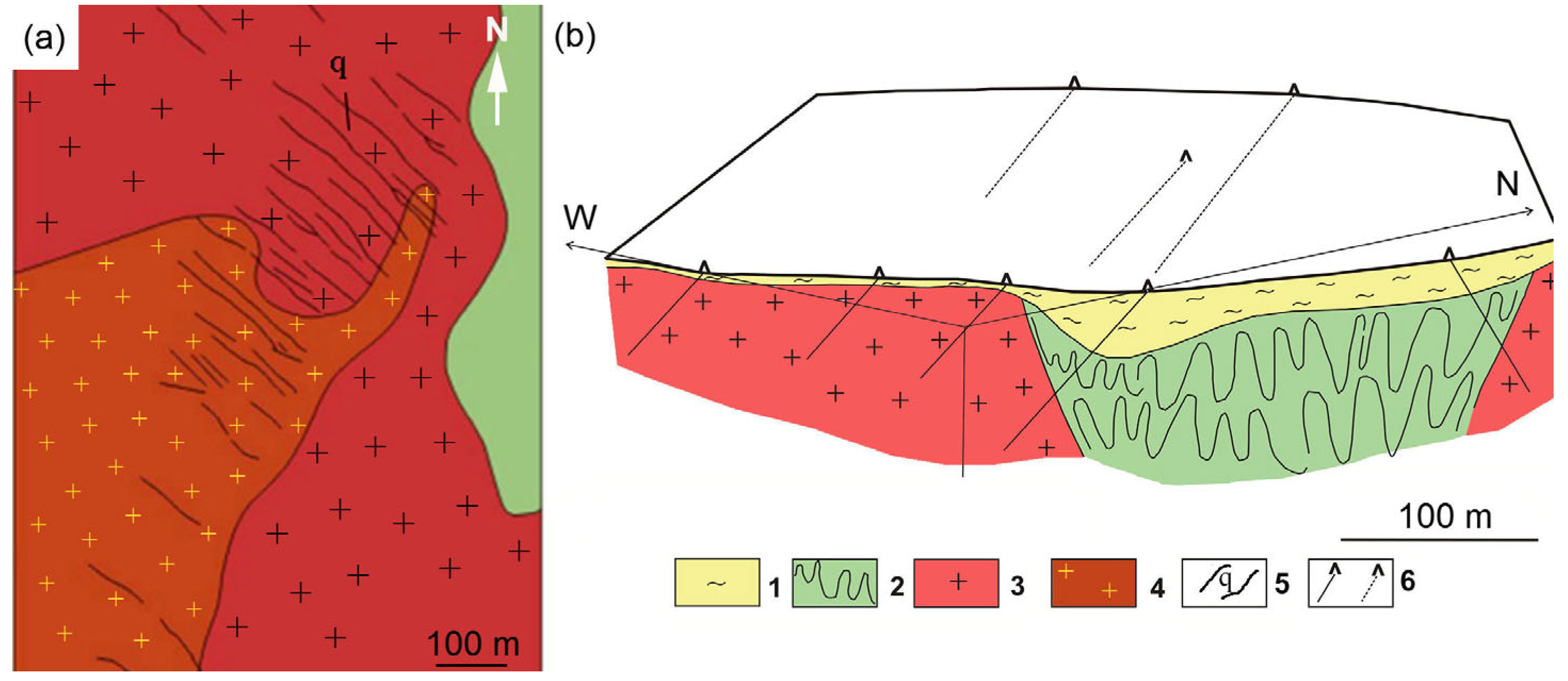
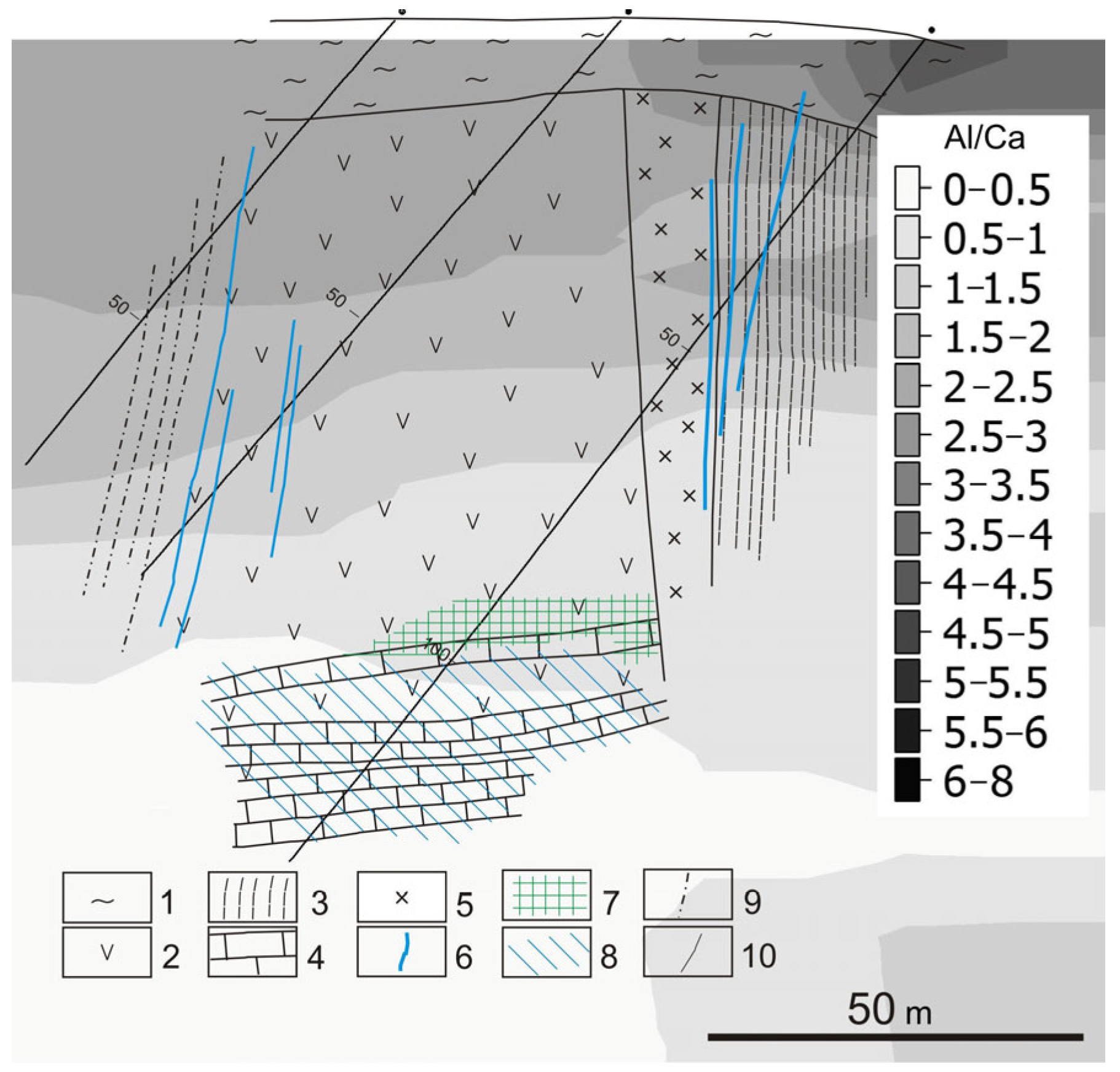
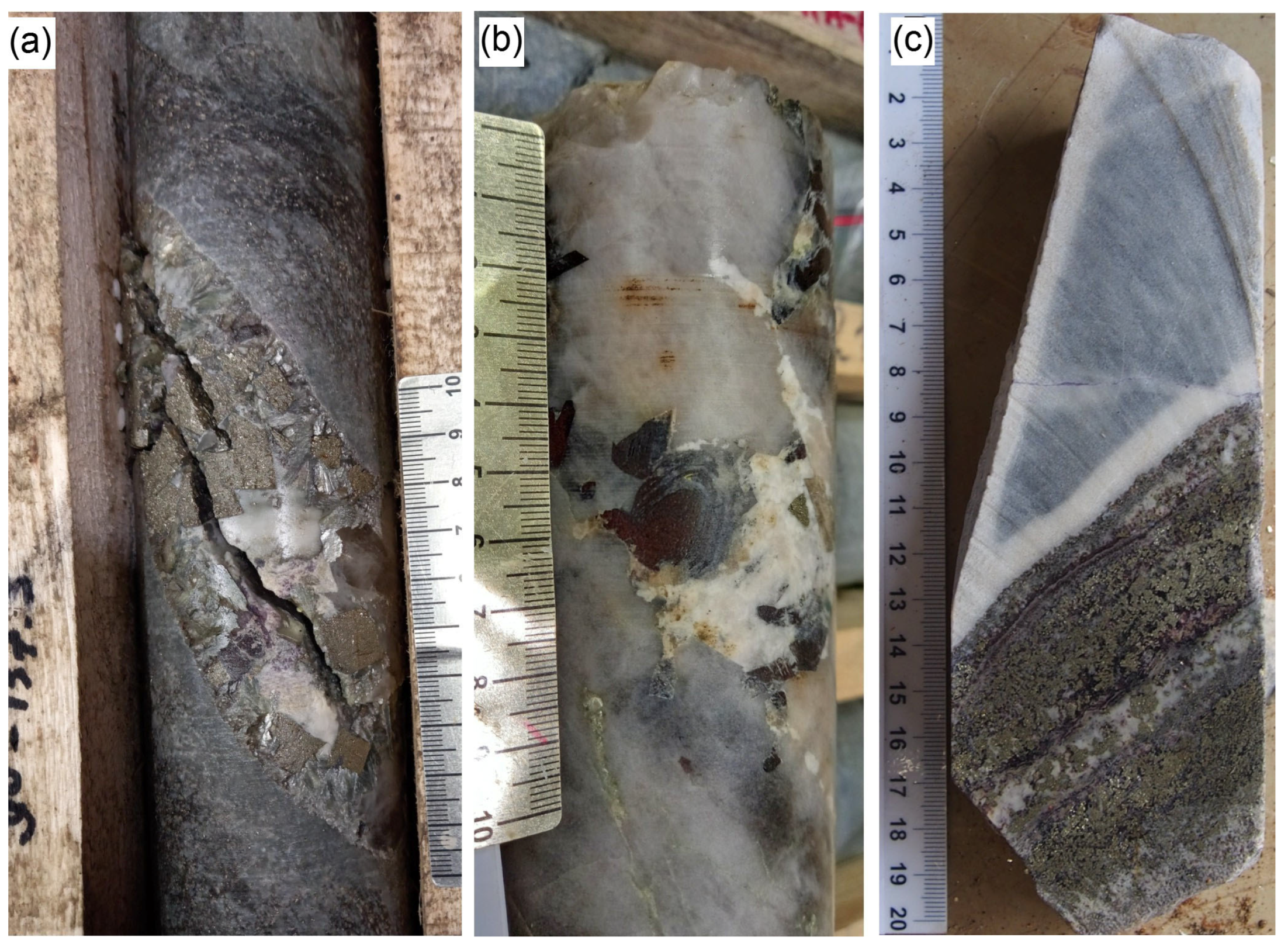



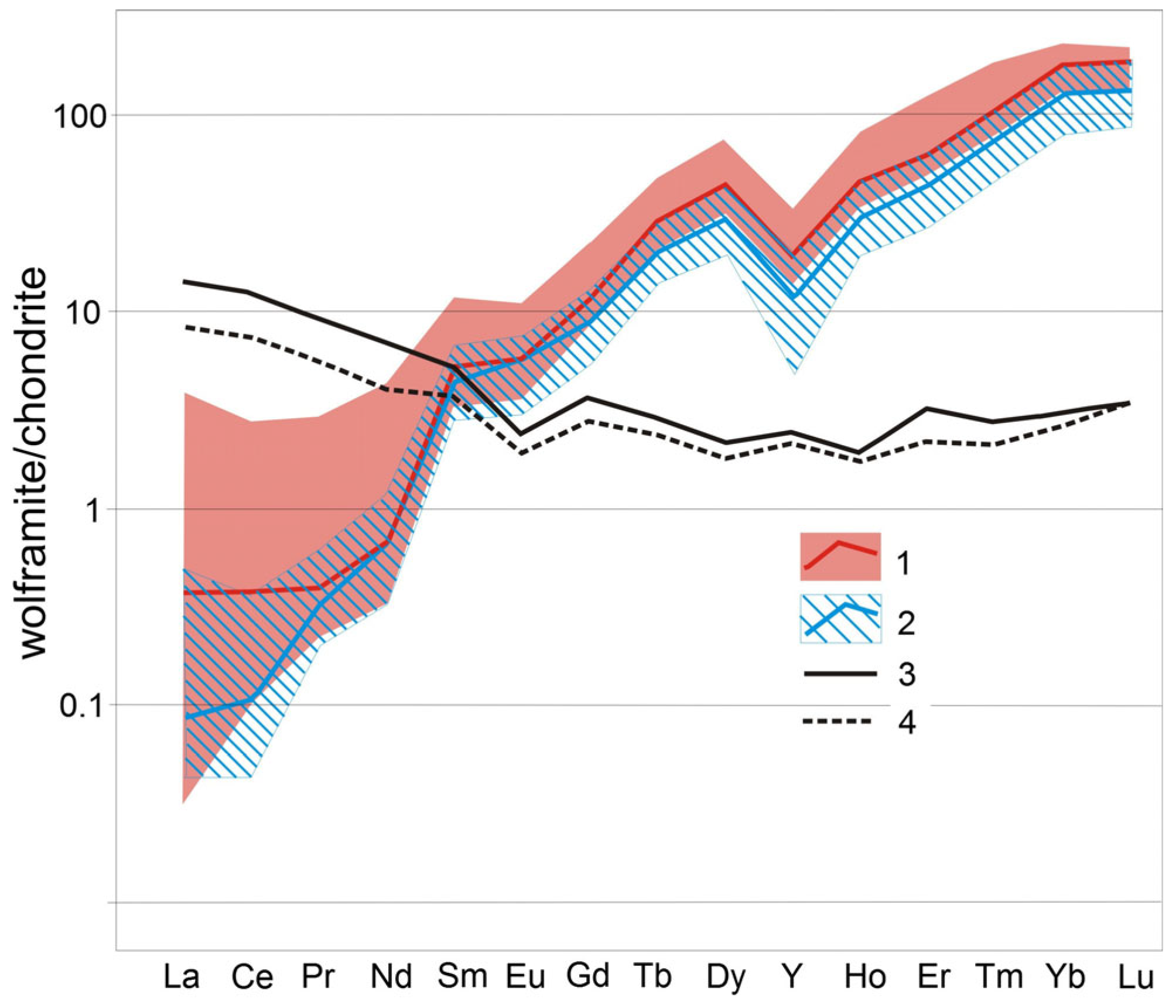
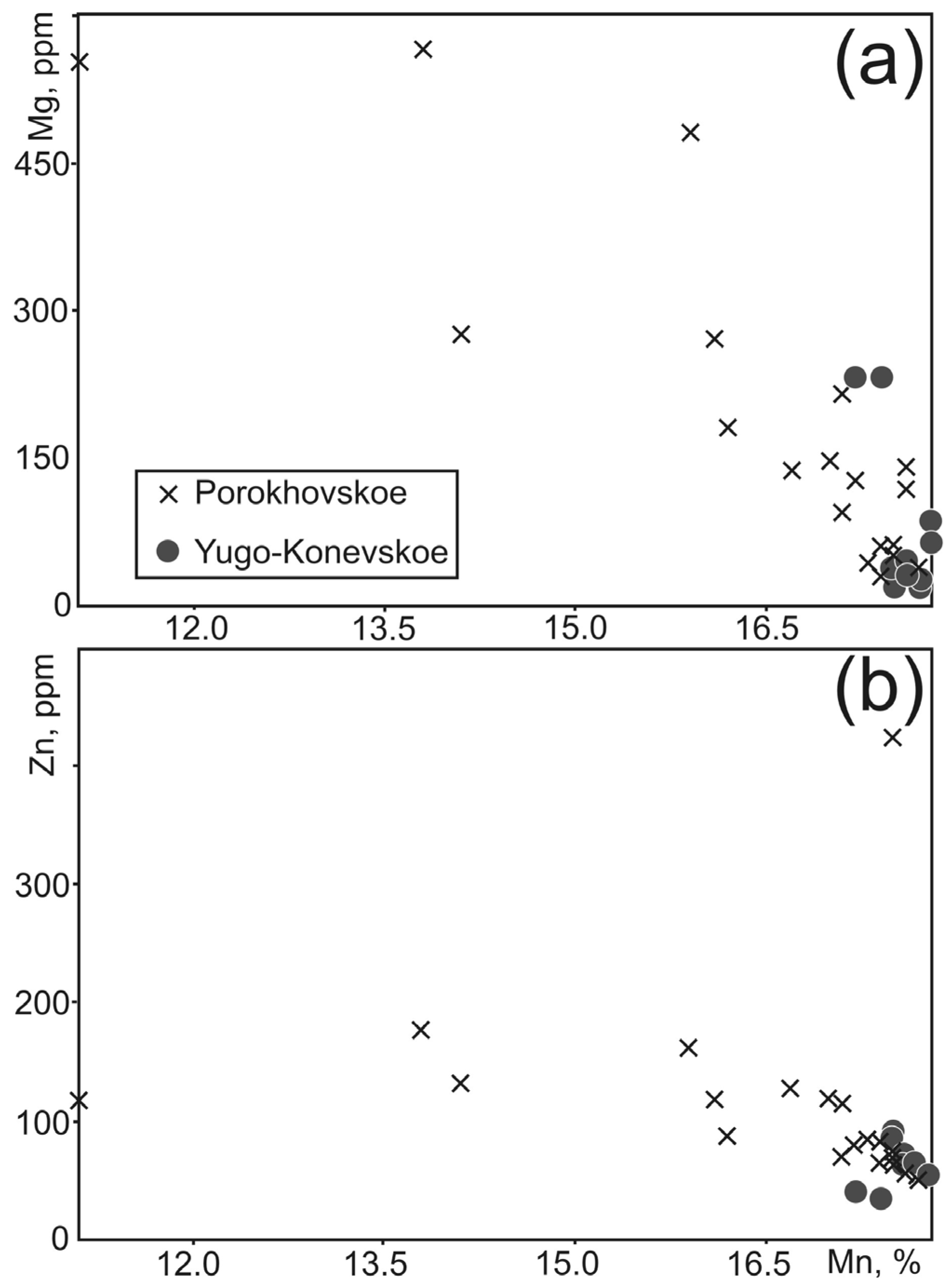
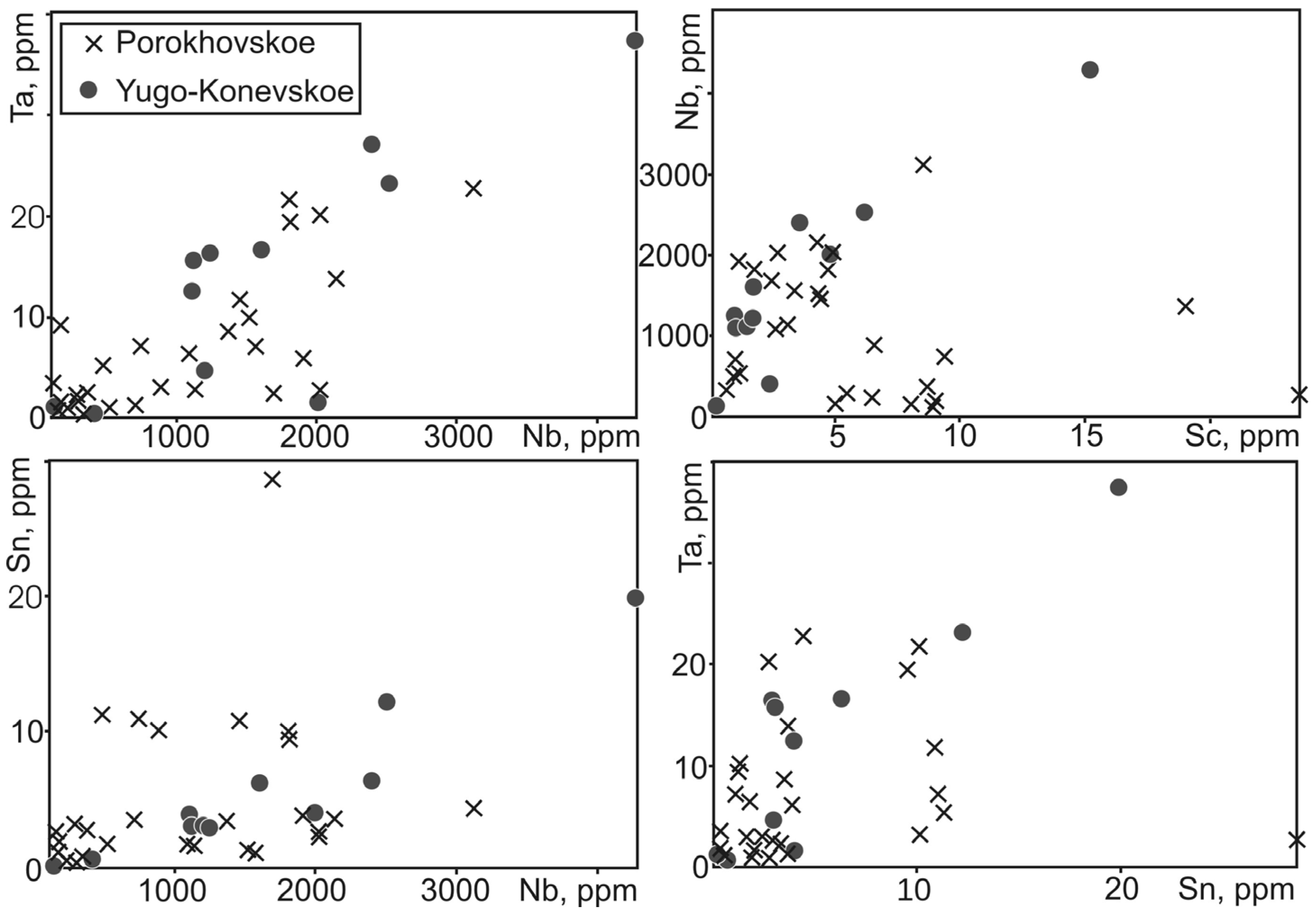
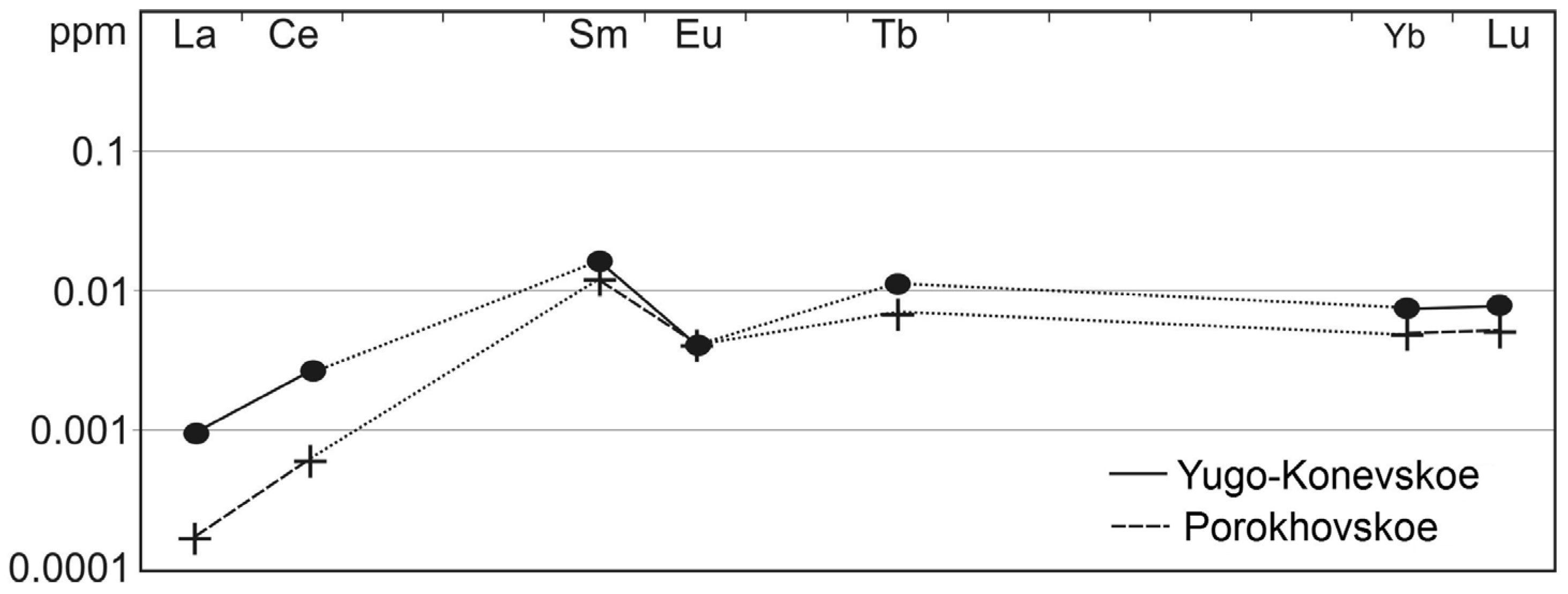
| Occurrence | MnO | FeO | WO3 | Fe/(Fe + Mn) |
|---|---|---|---|---|
| Yugo-Konevskoe (N = 3) | (20.79–22.34) | (1.05–2.73) | (76.48–76.94) | (0.04–0.12) |
| Porokhovskoe (N = 61) | 22.15 (11.54–22.98) | 0.9 (0.36–11.61) | 76.78 (76.14–77.49) | 0.04 (0.02–0.50) |
| Mg | Zn | Co | Sc | Nb | Ta | Mo | Sn | Ti | Zr | Hf | |
|---|---|---|---|---|---|---|---|---|---|---|---|
| Yugo-Konevskoe deposit (N = 12) | |||||||||||
| Min | 18.2 | 34.6 | 0.0 | 0.1 | 135 | 0.5 | 3.5 | 0.1 | 5.5 | 1.1 | 0.02 |
| Max | 232.7 | 89.6 | 0.4 | 15.2 | 4283 | 37.4 | 18.7 | 19.9 | 94.4 | 132.2 | 3.4 |
| Average | 70.5 | 61.9 | 0.1 | 3.3 | 1514.5 | 13.2 | 8.8 | 5.2 | 25.5 | 24.5 | 0.8 |
| St. Dev. | 78.0 | 15.3 | 0.1 | 4.2 | 1174.4 | 11.9 | 4.6 | 5.7 | 31.3 | 38.7 | 1.1 |
| Median | 36 | 62.2 | 0.03 | 1.7 | 1224 | 14.1 | 6.9 | 3.6 | 8.6 | 9.5 | 0.4 |
| 1 quartile | 24.3 | 55.1 | 0.01 | 1 | 586 | 1.2 | 6 | 1.3 | 7 | 3.7 | 0.2 |
| 3 quartile | 80.2 | 68.7 | 0.1 | 4.5 | 2305 | 21.6 | 12.8 | 6.4 | 30 | 23.1 | 1.2 |
| Skewness | 1.8 | 0.1 | 3.1 | 2.4 | 1.1 | 0.7 | 1.2 | 1.8 | 1.8 | 2.4 | 1.7 |
| Kurtosis | 1.9 | 0.4 | 10.3 | 6.6 | 1.7 | −0.3 | 1.4 | 3.5 | 1.9 | 5.8 | 2.3 |
| Porokhovskoe deposit (N = 20) | |||||||||||
| Min | 22.1 | 50 | 0.001 | 0.6 | 115 | 0.3 | 3.0 | 0.3 | 2.7 | 1.3 | 0.03 |
| Max | 566 | 424 | 3.4 | 23.6 | 3121 | 22.7 | 40.8 | 28.6 | 72.5 | 66.3 | 4.0 |
| Average | 138.5 | 98.7 | 0.3 | 5.8 | 1078.5 | 7 | 8.6 | 4.9 | 21.0 | 16.7 | 0.8 |
| St. Dev. | 157.9 | 72.1 | 0.7 | 5.2 | 798.4 | 6.8 | 8.1 | 5.9 | 19.3 | 17.8 | 0.9 |
| Median | 60.1 | 71.9 | 0.05 | 4.6 | 989.8 | 4.3 | 6.5 | 2.8 | 12.4 | 10.9 | 0.5 |
| 1 quartile | 34.6 | 63.7 | 0.02 | 2.4 | 314.3 | 1.9 | 3.8 | 1.4 | 7.0 | 5.2 | 0.2 |
| 3 quartile | 172.7 | 117.5 | 0.3 | 8.4 | 1780 | 9.8 | 8.6 | 8.2 | 25.3 | 20.0 | 0.9 |
| Skewness | 1.8 | 3.7 | 4.3 | 2.1 | 0.6 | 1.2 | 2.9 | 2.7 | 1.4 | 1.9 | 2.2 |
| Kurtosis | 2.5 | 16 | 20.6 | 5.1 | −0.3 | 0.4 | 9.1 | 9.1 | 0.9 | 3.1 | 5.0 |
Disclaimer/Publisher’s Note: The statements, opinions and data contained in all publications are solely those of the individual author(s) and contributor(s) and not of MDPI and/or the editor(s). MDPI and/or the editor(s) disclaim responsibility for any injury to people or property resulting from any ideas, methods, instructions or products referred to in the content. |
© 2025 by the authors. Licensee MDPI, Basel, Switzerland. This article is an open access article distributed under the terms and conditions of the Creative Commons Attribution (CC BY) license (https://creativecommons.org/licenses/by/4.0/).
Share and Cite
Novoselov, K.; Rogov, D.; Artemyev, D.A. Chemical Composition of Wolframite from the Porokhovskoe and Yugo-Konevskoe W Deposits (Central Urals): Implications for Fluid Evolution and Ore Genesis. Minerals 2025, 15, 661. https://doi.org/10.3390/min15060661
Novoselov K, Rogov D, Artemyev DA. Chemical Composition of Wolframite from the Porokhovskoe and Yugo-Konevskoe W Deposits (Central Urals): Implications for Fluid Evolution and Ore Genesis. Minerals. 2025; 15(6):661. https://doi.org/10.3390/min15060661
Chicago/Turabian StyleNovoselov, Konstantin, Danil Rogov, and Dmitry A. Artemyev. 2025. "Chemical Composition of Wolframite from the Porokhovskoe and Yugo-Konevskoe W Deposits (Central Urals): Implications for Fluid Evolution and Ore Genesis" Minerals 15, no. 6: 661. https://doi.org/10.3390/min15060661
APA StyleNovoselov, K., Rogov, D., & Artemyev, D. A. (2025). Chemical Composition of Wolframite from the Porokhovskoe and Yugo-Konevskoe W Deposits (Central Urals): Implications for Fluid Evolution and Ore Genesis. Minerals, 15(6), 661. https://doi.org/10.3390/min15060661







